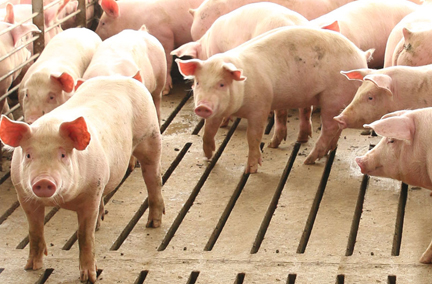
SHIC, launched by the National Pork Board in 2015 solely with Pork Checkoff funding, continues to focus efforts on prevention, preparedness, and response to novel and emerging swine disease for the benefit of US swine health. As a conduit of information and research, SHIC encourages sharing of its publications and research. Forward, reprint, and quote SHIC material freely. SHIC is funded by America’s pork producers to fulfill its mission to protect and enhance the health of the US swine herd. For more information, visit http://www.swinehealth.org or contact Dr. Sundberg at [email protected].

ProMED, a program of the International Society for Infectious Diseases, published an article on September 22, 2022, reporting an undiagnosed swine disease in Ecuador. This report stated CSF has been ruled out in the Esmeraldas province after a disease alert was raised on September 7, 2022. No additional alerts have been issued.
The lab at Agrocalidad, Ecuador’s agriculture quality assurance agency, tested two dozen samples, subsequently issuing the negative results for CSF. The Ministry of Agriculture and Livestock in Ecuador is engaged and the ProMED report said sites where the undiagnosed disease were located had been visited with sanitary work carried out.
The “Global Program – Transboundary Animal Diseases” (GF-TADs) is a joint initiative of the WOAH and FAO to help in the fight against the most significant transboundary animal diseases around the world. Because of USDA’s continued offer for diagnostic assistance through the Caribbean as well as Central and South America, the GF-TADS is aware of the outbreak and has offered additional diagnostic support from laboratories recognized by WOAH for their ability to confidently process diagnostic samples and test for ASF.
Even though the testing has been negative for CSF, immunizations for CSF are underway with the report stating 42 farms and 596 animals would be involved. The ProMed article reported there are two vaccination operators in the Esmeraldas province and wider plans for immunizations exist. “In the green province, a vaccination goal of 745 000 animals has been established and 53 000 doses have already been applied so far. In San Lorenzo around 1531 animals have already been inoculated within the immunization process for pigs.”
SHIC will continue to monitor the situation in Ecuador where a definitive diagnosis for the sick pigs is being sought.

This summer, the Swine Health Information Center Board of Directors voted to proceed with a collaborative effort to focus on wean-to-harvest biosecurity. SHIC, along with the Foundation for Food & Agriculture Research, an organization advancing actionable science to develop tools, technologies, and information benefiting farmers, consumers and the environment, and Pork Checkoff, will fund a Wean-to-Harvest Biosecurity Program to be implemented over the next two years.
“Wean-to-harvest biosecurity is a complex issue for our industry that has been developing for many years,” remarked SHIC Associate Director Dr. Megan Niederwerder. “This research program will look for cost-effective, innovative solutions to a significant biosecurity gap in US swine production.”
SHIC will contribute $1 million of reallocated funds from its current budget to the Wean-to-Harvest Biosecurity Program and FFAR will provide $1.15 million towards the effort. “FFAR envisions a world in which every person has access to affordable, nutritious food grown on thriving farms,” said Dr. Saharah Moon Chapotin, FFAR’s Executive Director. “Our partnership with SHIC and Pork Checkoff to support the bold research needed to develop solutions to safeguard the health of US swine will bring us closer to achieving that vision.”
The Pork Checkoff is contributing $150,000 as well. By leveraging budget allocation with the matching funds from FFAR and the Checkoff, SHIC increases capacity and output for its mission to safeguard the health of the US swine herd.
“SHIC is focused on preventing and responding to emerging diseases,” explained SHIC Executive Director Dr. Paul Sundberg. “Leading the industry in being proactive to controlling the next emerging disease instead of reacting after it gets here fulfills SHIC’s mission of protecting and enhancing US swine herd health.”
SHIC-funded Swine Disease Monitoring Report aggregate data shows breeding herd breaks of PRRS and PED tend to follow breaks in wean-to-harvest sites. A recently published paper on a SHIC-funded project detailed how PRRS and PED negative pigs placed on wean-to-finish sites become infected after placement. SHIC’s Rapid Response Team investigated an Actinobacillus pleuropneumoniae outbreak in the Midwest and exposed deficiencies of wean-to-harvest biosecurity in the area that contributed to the disease spread.
“The intent is to ensure solutions are implementable and provide significant value to producers,” stated Dr. Niederwerder. “Research priorities will be developed in three areas – bioexclusion for preventing disease introduction on the farm, biocontainment for preventing disease spread from the farm to reduce risk to neighbors, and transportation biosecurity for preventing disease movement from markets and concentration points back to the farm. We are seeking novel tools across all three areas for a comprehensive biosecurity approach.”
As part of the Wean-to-Harvest Biosecurity Program, SHIC established two task forces to develop specific, researchable priorities for the topic areas of transport biosecurity and site bioexclusion and biocontainment. With members from across the pork industry and academia, the Wean-to-Harvest Biosecurity Site Task Force and Wean-to-Harvest Biosecurity Transport Task Force have each met virtually to discuss priorities and ensure coordination across the pork industry, so there is no overlap in investigations and research providing the greatest return on investment. The priorities and call for proposals’ instructions will be posted to the SHIC website’s Wean-to-Harvest Biosecurity Program page as soon as they are completed. SHIC will facilitate proposal review and contract processes.
SHIC acknowledges the work will not be simple and could take some time to complete. Requests for proposals for related research will be issued as soon as possible so projects can start expediently. Due to anticipated seasonal effects and differences in costs and abilities to implement biosecurity, some projects will probably have to cross seasons, taking at least a year. However, SHIC says significant preliminary results will be shared immediately on the SHIC website’s Wean-to-Harvest Biosecurity Program page as well as via other communications.
FFAR builds public-private partnerships to fund bold research addressing big food and agriculture challenges. FFAR was established in the 2014 Farm Bill to increase public agriculture research investments, fill knowledge gaps and complement USDA’s research agenda. FFAR’s model matches federal funding from Congress with private funding, delivering a powerful return on taxpayer investment. Through collaboration and partnerships, FFAR advances actionable science benefiting farmers, consumers and the environment.
Click to hear Drs. Paul Sundberg and Megan Niederwerder discuss the Wean-to-Harvest Biosecurity Program on SHIC Talk.

In an article published on a Vietnamese agriculture news website during September 2022, positive ASF vaccination results and encouragement for stricter control were shared. Following a vaccination trial performed by the Vietnam Department of Animal Health on two farms with 258 pigs, officials said 20 localities have now deployed vaccinations with a total of more than 21,000 doses following all appropriate guidelines.
A visit to a family farm in Vinh Phuc province by the Deputy Minister of Agriculture and Rural Development and other representatives in early September gave the officials the opportunity for a vaccine trial and observation. On one of the farms where the ASF vaccine was deployed in two rounds, several pigs were noted to have mild fevers but all were stable at the time of the farm visit.
Responding to deaths of pigs receiving an ASF vaccine in Binh Dinh, Phu Yen and Quang Ngai provinces, officials determined it was caused by uncontrolled vaccination processes out of compliance with Ministry guidelines, at incorrect ages and dosages. It was said deaths of post-vaccination pigs could be attributed to the supply and sale of vaccines directly to veterinarians and farmers for self-vaccination.
As a result of their positive findings in Vinh Phuc province, Ministry officials intend to expand ASF vaccinations soon. Their plans are to deploy up to 600,000 doses. Stricter control of the vaccination process, in accordance with the guidelines of the Ministry, Department of Animal Health instructions, and with the correct vaccination targets will guide the process. Supervision to evaluate effectiveness of the vaccine will continue.

An ongoing collaboration between SHIC and the Center for the Ecology of Infectious Diseases at the University of Georgia examines spillover risk of bacteria from North American wild mammal species into the US swine herd. This collaboration will result in enhanced information needed to prevent, prepare, and respond to emerging diseases and their potential impact on swine health, welfare, and market.
The first phase of the project identified 102 bacteria species hosted by 127 North American wild mammal species that have a ≥ 97.1% chance of associating with domestic pigs. These bacteria species were assigned a propensity score based on their predicted ability of spilling over from their wild mammal hosts into domestic swine. A classification of either “novel” or “known” was also assigned based on whether or not these species had a known association with pigs documented in scientific literature.
A survey of subject matter experts was the second phase of the project. The goal of the survey was to rank the 102 bacteria species to assess their potential impact on the swine industry via potential effects on public health, antimicrobial resistance, and swine welfare, production, morbidity, and mortality. A limited number of industry professionals completed the survey and identified 16 bacteria species as being of high impact to the swine industry, four of which are not yet known to infect domestic swine: Anaplasma bovis (98.7% modeled chance of spilling over into swine), Clostridium botulinum (98.7%), Klebsiella pneumoniae (98.6%), and Yersinia pestis (99.7%). Additionally, seven bacteria were ranked as having a high-risk of antimicrobial resistance and five bacteria were ranked as having a high human outbreak potential. Results of the analysis uncovered two novel bacteria that are found in pigs, which helps validate the predictive model.
Industry professionals across disciplines hold valuable insights crucial to informing risks related to emerging diseases. Their collective knowledge based on years of expertise fills a gap in the absence of a comprehensive database on the pathogenicity of swine-associated bacteria. A lack of published academic literature also fuels the need to engage subject matter experts to develop a systematic process for identifying bacterial species of concern to the swine industry, and this research represents a summary of such an endeavor.
Due to the limited response to the qualitative survey, additional effort to increase its power by seeking more responses is underway. Other upcoming activities include continued work to investigate pathways for potential spillover events, such as shared habitats between wildlife and domestic swine, or pathogen overlap. Additionally, different bacterial strains, serovars, and variants of bacteria species of concern must be closely examined to increase predictive power.
Bacteria account for a high degree of morbidity and mortality in swine, causing huge losses to the swine industry and zoonotic risks. Domestic pigs often acquire these pathogens (either directly or indirectly) from wild animals, creating the need for assessments such as these to prioritize bacteria species for targeted prevention strategies.

In a SHIC-funded effort aimed at increasing swine disease prevention and preparedness, staff with the Morrison Swine Health Monitoring Project are developing a methodology to communicate with project participants whenever a swine disease is occurring in the region near their sites. Whether an endemic or emerging disease, the goal is to be able to quickly report regional status to producers, allowing them to take precautions to protect their herds, per Dr. Mariana Kikuti, researcher, University of Minnesota Department of Veterinary Medicine.
“For example, if a producer’s neighbor tested positive for PRRS, or maybe ASF in the future, they would be notified and able to take necessary precautions,” Dr. Kikuti explained. However, the benefits extend beyond the producer level as well. “Indirectly, this program may also be able to facilitate the interaction between producers and animal health authorities in the face of an FAD.”
Dr. Kikuti her colleagues say this project is possible because of MSHMP’s primary mission, capturing and analyzing swine health data on a weekly basis from participating farms. Work to take that data and find a useful radius for notifications counting positive sites in a given region is underway. The program has been tested with one company participating in MSHMP, giving researchers a baseline for continued development, beginning with PRRS monitoring and reporting.
When the project is complete, MSHMP will weekly calculate the distance between a site that has recently reported an outbreak and neighboring MSHMP sites. From there, the team will develop a communication system to share regional incidence of disease with participants in a timely fashion, to allow the opportunity to put measures for disease prevention in place. Finally, they will automate the analysis to allow for seamless incorporation of the information for participants followed by open enrollment for non-MSHMP participants once the methodology has been established.
After testing the concept, MSHMP has brought on a postdoctoral fellow who will be 100% focused on accomplishing the project’s objectives. Dr. Xiaomei Yue is an animal health economist with a focus on the production and economic effects of animal disease surveillance programs on herds. She conducts retrospective and predictive research on disease surveillance programs to provide decision makers with insights into more effective animal disease control programs.

The symposium Japanese Encephalitis Virus: Emerging Global Threat to Humans and Livestock will be held October 17-19, 2022 in the Center for the Ecology of Infectious Diseases at the University of Georgia. Sponsored in part by SHIC, the symposium is dedicated to furthering understanding of the current JEV outbreak in Australia, and JEV’s potential for global impact on human and domestic animal populations. Registration (https://www.ceid.uga.edu/jev2022/) for the hybrid event is open for virtual or in-person participation.
Symposium events will feature a keynote address by Dr. Mark Shipp, Australian Chief Veterinary Officer who will discuss how the Australian government responded during the 2022 JEV outbreak. Additionally, Drs. Bernie Gleeson and Kirsty Richards with SunPork Farms Australia will discuss how the recent JEV outbreak impacted their operations, what they’ve learned, and how they are preparing for the next mosquito season. Also planned are presentations by USDA about US diagnostic capabilities, the risk of JEV introduction into the United States, JEV surveillance, and current USDA and public health response plans. Breakout sessions to brainstorm and assimilate into research objectives and next steps will also occur. Meals will be provided.
The event is supported by the Global Infectious Disease Intelligence Consortium and the Center for the Ecology of Infectious Diseases, University of Georgia.

This month’s Domestic Swine Disease Monitoring Report brings onboard Influenza A virus subtype detection by PCR data from all five participating veterinary diagnostic laboratory with a historical summary highlighted on the SDRS bonus page. Also, the SDRS reports increased activity of PRRSV in wean-to-finish sites, mainly in South Dakota, Nebraska, Missouri, Indiana, and Oklahoma. Mycoplasma hyopneumoniae also had an increase in detection in grow-finish sites, with some relationship with the increased PRRSV activity. PDCoV detection is still low across the US, having no positive submissions in the week of September 12. In the podcast, SDRS hosts talk with Dr. Andrew Bowman, associate professor at The Ohio State University, about the dynamics of Influenza A virus bi-directional transmission. They also talk about IAV spillover cases in agricultural state fairs and the importance of IAV vaccination in decreasing public health risks.

In the October Global Swine Disease Monitoring Report, read about Brazilian authorities seizing prohibited pork products from Russia at the Rio de Janeiro International Airport. A suspicious case reported in Ecuador tests negative for CSF and ASF. In South Korea, new ASF outbreaks in domestic pigs occur, with over 15,000 pigs culled.
Copyright 2024 | Swinehealth.org | Website by Heartland Marketing Group